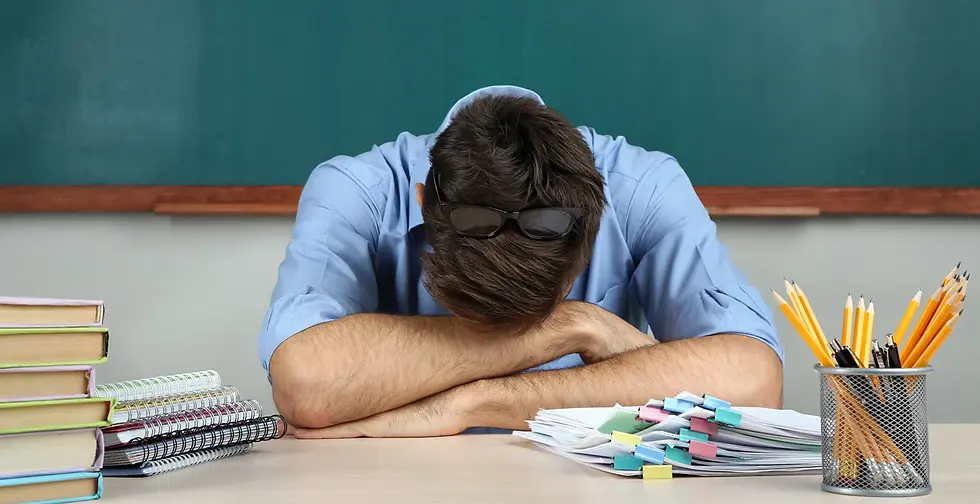Teacher Burnout: Causes, Effects, and Solutions to a Growing Crisis
- Coral Martínez-Cotto

- May 1
- 3 min read

Burnout isn’t just a buzzword in education. It’s a silent epidemic. Across classrooms in every zip code, passionate and committed teachers are running on empty. While they dedicate their lives to nurturing and guiding future generations, their own well-being is too often overlooked.
As a former teacher and school principal, I’ve both heard and said these words more times than I can count: “I’m exhausted, and I don’t know how much longer I can do this.”
This isn’t just a passing complaint. It’s a reflection of a deeper crisis in our schools—one where dedicated educators are pushed to their limits without the support they need to thrive.
Let’s take a closer look at the roots of teacher burnout, its ripple effects, and what we can do about it.
What Is Teacher Burnout?
Teacher burnout is a state of chronic physical and emotional exhaustion caused by prolonged stress and overwork. It is often marked by frustration, detachment, and a loss of motivation, especially in environments where teachers once felt deeply called to serve.
Causes: What’s Fueling the Fire?
There isn’t one single cause of burnout. It’s a perfect storm of stressors. Here are some of the top contributors:
Unmanageable Workloads: Teachers often juggle lesson planning, grading, data analysis, communication with families, meetings, and student crises—all within limited hours.
Lack of Autonomy: When educators are required to follow rigid programs without flexibility, it can erode their sense of professionalism and creativity.
Inadequate Support: From outdated technology to insufficient classroom aides, many teachers feel like they are building the plane while flying it. A lack of consistent support from school administration, including limited visibility, unclear communication, or failure to advocate for teacher needs, only adds to the pressure.
Challenging Student Needs: Rising behavior concerns, social-emotional challenges, and academic gaps demand more time and resources than most schools are equipped to provide.
Toxic School Culture: Poor leadership, lack of recognition, and punitive accountability systems can turn a school from a place of purpose into a place of stress.
The Effects: When Burnout Goes Unaddressed
Teacher burnout doesn’t just impact individual educators. Its effects ripple through entire school communities.
High Turnover Rates: When burned-out teachers leave the profession, it leads to staffing shortages, inconsistency, and instability for students.
Lower Student Achievement: Burnout affects instructional quality. Students miss out on meaningful learning when their teachers are exhausted or disengaged.
Decline in Mental and Physical Health: Burnout is linked to anxiety, depression, sleep disorders, and other chronic health issues.
Loss of Passion: Many educators enter the field with purpose and heart. Burnout dims that light and leaves even the most dedicated professionals questioning their future.
Solutions: Where Do We Go From Here?
The good news is that burnout is not inevitable. Here are some research-based and real-world strategies schools and leaders can implement now:
Prioritize Planning Time: Protect teachers’ time during the school day. Reduce meetings and unnecessary paperwork to allow space for preparation and reflection.
Invest in Mental Health and Wellness: Provide access to counseling services, wellness programs, and trauma-informed training, not just for students, but for staff too.
Create a Culture of Appreciation: Recognition goes a long way. Celebrate small wins. Listen to teacher input. Build trust through transparency and authentic leadership.
Strengthen Instructional and Operational Support: Add instructional coaches, behavior support staff, and clerical assistance. Teachers should not carry the weight of entire systems on their own.
Offer Professional Growth Opportunities: Empower teachers to lead, innovate, and grow. Professional development should inspire and equip, not overwhelm.
Foster Collaboration, Not Competition: Encourage peer mentorship and shared planning. Strong relationships reduce isolation and build collective resilience.
Final Thoughts
Teacher burnout is real, but it is not a personal failure. It is a systemic issue that requires systemic change.
Teachers deserve more than just self-care tips. They deserve sustainable systems, strong leadership, and the support to thrive.
If you are a school leader, I invite you to reflect on how your systems either support or strain your team. And if you are a teacher reading this, I see you. You are not alone.
Let’s build schools where everyone can thrive, starting with those who lead the learning.




Comments